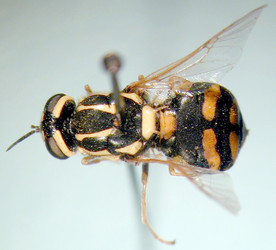Caloparyphus
Keith Bayless- Caloparyphus amplus
- Caloparyphus atriventris
- Caloparyphus crotchi
- Caloparyphus crucigerus
- Caloparyphus currani
- Caloparyphus decemmaculatus
- Caloparyphus flaviventris
- Caloparyphus greylockensis
- Caloparyphus major
- Caloparyphus mariposa
- Caloparyphus pretiosus
- Caloparyphus tetraspilus
Introduction
The 12 species of Caloparyphus are found in the U.S. and Canada, with C. decemmaculatus ranging into Mexico.Characteristics
Caloparyphus are large, black flies with some abdominal patterning. Caloparyphus is distinguished from other Nearctic Oxycerini by the elongated antenna, pedicel shorter than the combined length of the basal three flagellomeres, the scutellar spines separated by at least their length (if the scutellar spines are closer, the wing with only scattered microtrichia distally), and aedeagus trifurcated distally (James 1981).
References
James, M.T. 1981. 36. Stratiomyidae. Manual Nearct. Dipt. 1: 497-511.
Woodley, N. E. 2001. A World Catalog of the Stratiomyidae (Insecta: Diptera). Myia 11: 1-473. Backhuys Publishers, Leiden.
Information on the Internet
- Harvard MCZ Type Images. Images of Caloparyphus crotchi.
- Harvard MCZ Type Images. Images of Caloparyphus greylockensis.
- Harvard MCZ Type Images. Images of Caloparyphus pretiosus.
- Harvard MCZ Type Images. Images of Caloparyphus tetraspilus.
Title Illustrations

| Scientific Name | Caloparyphus flaviventris |
|---|---|
| Location | California; Modoc Co; Lake City |
| Specimen Condition | Dead Specimen |
| Identified By | James |
| Life Cycle Stage | Adult |
| View | Dorsal |
| Collection | California Academy of Sciences |
| Type | Holotype |
| Collector | C. L. Fox |
| Source | Caloparyphus flaviventris |
| Image Use |
 This media file is licensed under the Creative Commons Attribution-NonCommercial License - Version 2.5. This media file is licensed under the Creative Commons Attribution-NonCommercial License - Version 2.5.
|
| Copyright |
© Martin Hauser

|
About This Page
Keith Bayless

North Carolina State University, Raleigh, North Carolina, USA
Correspondence regarding this page should be directed to Keith Bayless at
Page copyright © 2008 Keith Bayless
All Rights Reserved.
- First online 28 September 2008
- Content changed 28 September 2008
Citing this page:
Bayless, Keith. 2008. Caloparyphus. Version 28 September 2008 (under construction). http://tolweb.org/Caloparyphus/108786/2008.09.28 in The Tree of Life Web Project, http://tolweb.org/








 Go to quick links
Go to quick search
Go to navigation for this section of the ToL site
Go to detailed links for the ToL site
Go to quick links
Go to quick search
Go to navigation for this section of the ToL site
Go to detailed links for the ToL site